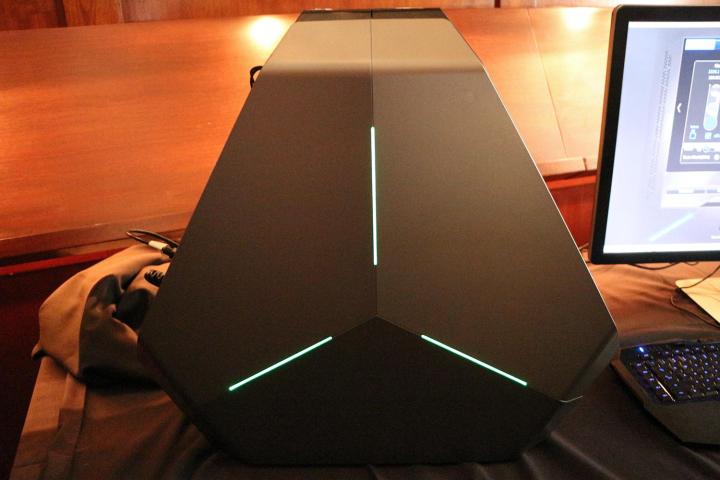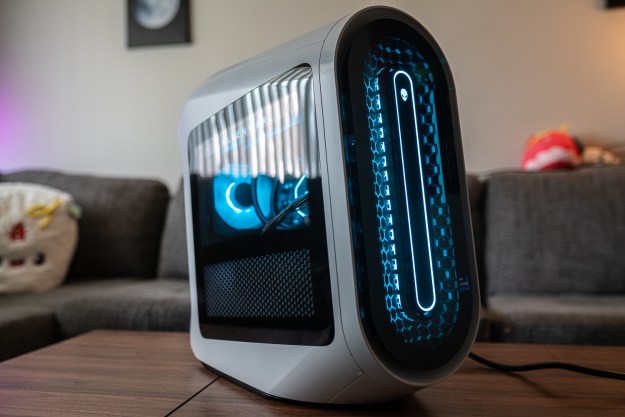
As we expected, the Alienware Area 51 will be highly configurable. For starters, you can outfit it with one of three Intel Core i7 processors. Options consist of the 5820K, 5930K, or the 5960X. The first two are six-core chips, while the latter is an eight-core beast. The 5820K runs at 3.3GHz, the 5930K is clocked at 3.5GHz, while the 5960X operates at 3GHz. The standard Area 51 ships with the 5820K.
Though the pursuit of peak performance is admirable, we actually think these chips (especially the 5960X) are overkill. We wish there were some Core i5 options available, which would make for a cheaper, but still super-powerful system.
The graphics card options are more robust. The base model Area 51 will ship with an AMD Radeon R9 270, but you can opt for an Nvidia GeForce GTX 770, 780, 980, or Titan Z as well. Dual and triple graphics card options are available too, but there’s a bit of confusion here.
Aside from the R9 270, the only other AMD card that’s available with the Area 51 is the Radeon R9 290X. However, this will only be available in a triple card configuration. You can’t outfit the Area 51 with a pair of 290X cards, or even a solo unit. You also can’t get two or three Radeon R9 270s in here, just one. That’s peculiar.
The Area 51 includes 8GB of RAM, and a 2TB mechanical hard drive by default. However, you can bump the former up to either 16GB or 32GB, and the latter to an SSD that’s either 128GB, 256GB, or 512GB. The 128GB is paired with a 2TB hard drive, while both the 256GB and 512GB SSDS each come with 4TB hard drives.
The Area 51’s chassis will ship with a multitude of ports. On the front, you’ll find two USB 3.0 ports, mic and headphone jacks, and a memory card reader. On the back, the system stores four USB 3.0 connections, four USB 2.0 ports, a robust slate of audio ports, Ethernet, and a Kensington lock slot. If you don’t want to connect to the Internet using a cable, you’ll be all set to go anyway. The Area 51 also has 802.11ac Wi-Fi built in, along with Bluetooth 4.0.
Whether you like it or not, Windows 8.1 is here to stay, for now at least. Sure, you can choose to install the free Windows 10 Technical Preview, but it can be glitchy. That’s why were glad Alienware provides the option of installing Windows 7 on the Area 51 too. However, it’s unclear whether that will come with an extra charge. 8.1 is provided with all models as a standard.
We hope you pump iron regularly, or at least have an elevator where you live, because the Area 51 is an absolute beast.
Its starting weight is listed at just over 61 pounds, and it measures 22.4 x 10.7 x 25.2-inches. However, when we went hands-on with it a couple of months back, we found that its built-in carrying handles make it much easier to hoist up and carry than you’d think, given its weight and measurements. Even so, remember, lift with your legs, not your back.
The Alienware Area 51’s chassis truly looks like a spacecraft, but it’s not just designed to turn heads. The ports and connections on the system are oriented so that they face upward, at an angle. That makes it easier for users who place the Area 51 under the desks to reach these parts of the PC when they’re sitting down. We appreciate practical, people-friendly design decisions like that.
To recap, the base model Alienware Area 51 includes an Intel Core i7-5820K CPU, 8GB of RAM, a 2TB hard drive, and an AMD Radeon R9 270 graphics card. You can grab this model for $1,699, though the cost of your Area 51 will vary depending on how you configure it.
The Alienware Area 51 launches October 28.
Editors' Recommendations
- This Alienware gaming PC with i9 and RTX 4090 has a $500 discount
- Best gaming PC deals: Lenovo Legion, ASUS ROG, Acer Predator
- The simple reasons your PC games don’t play as well as they should
- This Lenovo gaming PC with RTX 3050 and 16GB of RAM is on sale for $650
- It’s time to stop settling for a noisy gaming PC


